|
| |
 The Eden Project The Eden Project
This page is about the
Eden Project, located near St. Austell in Cornwall, England.
You can click here to see a page with more, different
pictures about my visit.
|
|

|
So what's it all about then?
The Eden Project is run by Tim Smit (of Lost Gardens of Heligan fame),
who successfully raised money to build the world's largest greenhouse.
It aims to put on one site the complete range of natural plant habitats found on the Earth.
Costing around £74 million, it is one of the most impressive of
Britain's millennium ventures. The Millennium Commission has agreed a £37
million grant for the venture, the European Regional Development fund £10
million, Private Sector funds £17 million and the balance of £10 million from
a number of other grants.
It opened Easter 2001. The aim is to attract 750,000 visitors a year and provide a world-class centre for research into the environment.
The site is a Cornish clay-pit about a mile north of the road between
Lostwithiel and St Austell. It is called Bodelva.
|
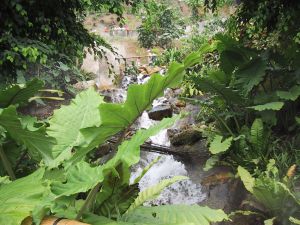 Why? Why?
With the emphasis in botany moving towards conservation, existing glasshouses
are not large enough to allow the study of populations of plants, rather than
individual species.
This study of populations is important in gaining understanding of sustainable development and plant bio-diversity.
|
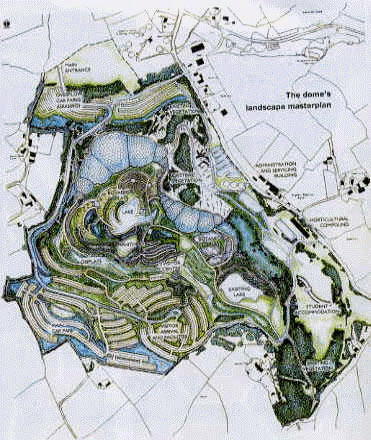 The Detail The Detail
The 'home' of the Eden Project is a dramatic global garden, the size of 30
football pitches, based in the natural theatre of a china clay pit overlooking
St Austell Bay in Cornwall.
The £75 million project will, by virtue of the nature and delivery of its
message, its scale and unique setting, become a visitor attraction of
international stature.
The Eden Project presents a breathtaking scene, the world in
microcosm - a cultural melting pot of global plants, both wild and cultivated.
The 60 metre deep crater contains thousands of important and beautiful
plants from our own temperate zone, the humid tropics and the warm temperate
regions of the world.
The two latter climatic zones are housed in giant
conservatories known as Biomes. The grounds also contain classrooms,
exhibition and conference facilities and assorted catering and retail
facilities.
The landscaped grounds cover 12 hectares wrapped around a central lake
displaying and interpreting plants from our own temperate climate, telling the
stories of the crops that have changed our world.
|
|
 Curved around the south facing wall of the pit
is the remarkable Humid
Tropic Biome - big enough to house The Tower of London, it contains plants
from Amazonia, West Africa, Malaysia and Oceania. Curved around the south facing wall of the pit
is the remarkable Humid
Tropic Biome - big enough to house The Tower of London, it contains plants
from Amazonia, West Africa, Malaysia and Oceania.
From rubber to cocoa, and from
vanilla orchids to bamboo.
Imagine the scale of this place, where teak and
mahogany will have enough room to reach their full potential, and where you're able to experience some of the world's most dramatic tropical flora.
|
|
 The Warm Temperate Biome transports you to California, Southern Africa
and the Mediterranean. The Warm Temperate Biome transports you to California, Southern Africa
and the Mediterranean.
Where you find orange groves, olives, grapevines and
hundreds of colourful flowers. Productive plants and natural beauty all under
one roof.
The vastness of the scheme is illustrated by showing that the equivalent of
13 Cathedrals can be fitted into just one of the four plant houses.
In the clay
pit there are 8 hectares of linked, climate controlled transparent biomes.
|
Under Construction
The Site
The brief was to create a spectacular theatre in which to tell the story of human
dependence on plants.
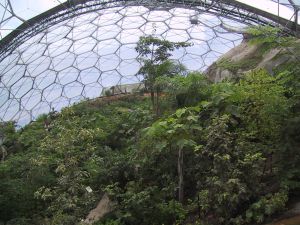 The team found a disused china clay pit, over 60 metres deep and the size of
35 football pitches, which was sheltered, south-facing and spectacular. The team found a disused china clay pit, over 60 metres deep and the size of
35 football pitches, which was sheltered, south-facing and spectacular.
'An
architect would fall over backwards wanting to build something in it,' said
David Kirkland of Nicholas Grimshaw & Partners.
Jerry O'Leary, Works
Manager, called it the biggest sand pit in the world.
The bad news: it was an
inverted cone shape with little level ground, unstable, prone to flooding, and
contained no soil.
The level of the bottom was raised 17 to 20 metres by slicing off the tops of the
spoil heaps surrounding the pit.
Twelve dumper trucks and eight bulldozers
shifted 1.8 million tonnes of dirt in six months.
Then, near-disaster: 43
million gallons of water (approx. 163 million litres) rained into the pit in three
months.
Our engineers came up with the drainage system to end all drainage
systems. It can easily handle the 22 litres/sec of water that runs into the pit
(that’s 20,000 bathfuls a day).
Dodgy slopes were shaved back to a safe angle and terraces chopped out. Two
thousand rock anchors, some up to 11 metres long, were driven into the pit sides to
stabilise them, and a 'soup' of plant seed and plant food sprayed on the
slopes to knit the surface together.
The Biomes
The Biomes are the biggest conservatories in the world, beautiful, iconic
and sustainable.
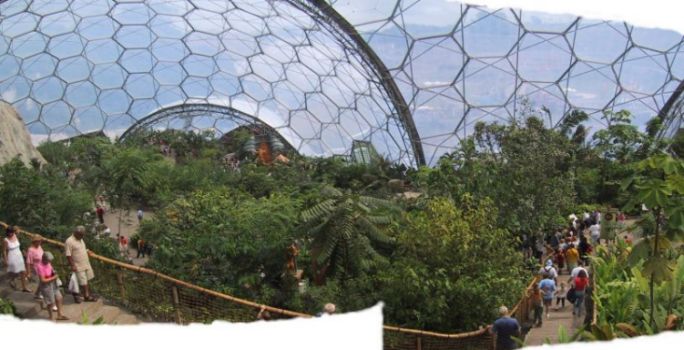
The Humid Tropics Biome, which could hold the Tower of London,
is 11 double-decker buses high and 24 long, with no internal supports.
It made
the Guinness Book of Records for the largest free-standing scaffold ever built -
12 levels, 25 metres across, with 46,000 poles, which laid end to end would stretch
230 miles.
 Building a lean-to greenhouse on an uneven surface that changed shape was
tricky.
Building a lean-to greenhouse on an uneven surface that changed shape was
tricky.
Bubbles were used as they can settle perfectly on to any shaped surface.
The bubbles were made of hexagons, copying insects' eyes and honeycombs. This
commonsense nature produces maximum effect with minimum resources.
The Biomes'
steelwork weighs only slightly more than the air they contain.
They are more
likely to blow away than blow down, so they are anchored into the foundations
with steel ground anchors: 12-metre tent pegs!
|
|
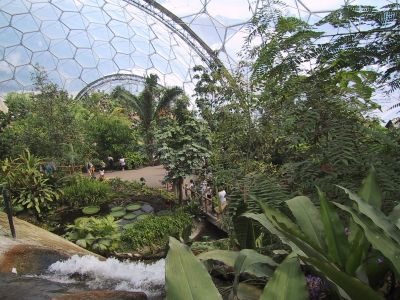 The final design comprised a
two-layer steel curved space frame, the hex-tri-hex, with an outer layer of
hexagons (the largest 11 metres across), plus the occasional pentagon, and an inner
layer of hexagons and triangles (resembling huge stars) all bolted together like
a giant Meccano kit. Each component was individually numbered, fitting into its
own spot in the structure and nowhere else. The final design comprised a
two-layer steel curved space frame, the hex-tri-hex, with an outer layer of
hexagons (the largest 11 metres across), plus the occasional pentagon, and an inner
layer of hexagons and triangles (resembling huge stars) all bolted together like
a giant Meccano kit. Each component was individually numbered, fitting into its
own spot in the structure and nowhere else.
The transparent foil 'windows', made of 3 layers of ETFE (ethylenetetrafluoroethylene-copolymer),
form inflated 2-metre-deep pillows.
ETFE has a lifespan of over 25 years,
transmits UV light, is non-stick, self-cleaning and weighs less than 1% of the
equivalent area of glass. It’s also tough: a hexagon can take the weight of a
rugby team!
The pillows were installed by 22 professional abseilers - the sky
monkeys.
|
Key Dates
Key dates in the life of Eden:
 | In 1994:
Whilst driving round the china clay quarry landscape around St
Austell, Tim Smit conceives an idea of building the world's largest
greenhouse. |
 | October 1998:
Building work on the Eden Project gets underway. |
 | December 1998:
Rain stops play, and work at the site is suspended. |
 | March 1999:
The bulldozers and dumper trucks are back in action and work
flat out for six months to clear the site. |
 | May 2000:
Phase One - The Gateway to Eden - opens to the public.
Between
now and January 2001, half a million visitors will come to watch the Big
Build. |
 | October 2000:
The first trees are planted in the Humid Tropics Biome. |
 | January 2001:
Phase One closes so that the final construction work can be
completed on the link building, and modifications made to the visitor
centre. |
 | March 2001:
The Eden Project opens fully to the public. |
 | June 2001:
Millionth Visitor passes through the gates of Eden. |
|
Visitors' Centre
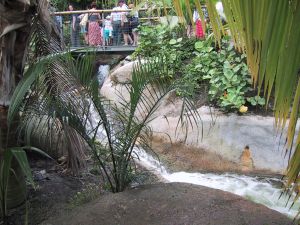 A Visitors' Centre provides a gateway to the biomes and the
temperate parkland surrounding. A Visitors' Centre provides a gateway to the biomes and the
temperate parkland surrounding.
Much is planned for the centre...
Over time, visitors will experience the world of
plants - using micro and time-lapse photography.
They will embark on a journey through the veins of plants, taking in the
cycle of life and death, regeneration and decay.
See the miracle that is
photosynthesis - the key to life on earth.
|
|
Initially, the Biomes encapsulate
4 key climatic regions: rainforest, semi-desert, sub-tropics and Mediterranean.
These host not only the greatest bio-diversity, but also the widest range of
plants used by man.
The scheme is the world's largest environmentally controlled
glass-house, containing a databank of all major plant species across the globe.
The
project uses the latest technology and materials to create a dramatic centre
into a modern rival of the great glass and iron structures of the 19th century.
Its range of interest has an almost universal appeal from the most esoteric scientist to a child of six.
Map of Eden
Here's a map of the site when I visited: |
|
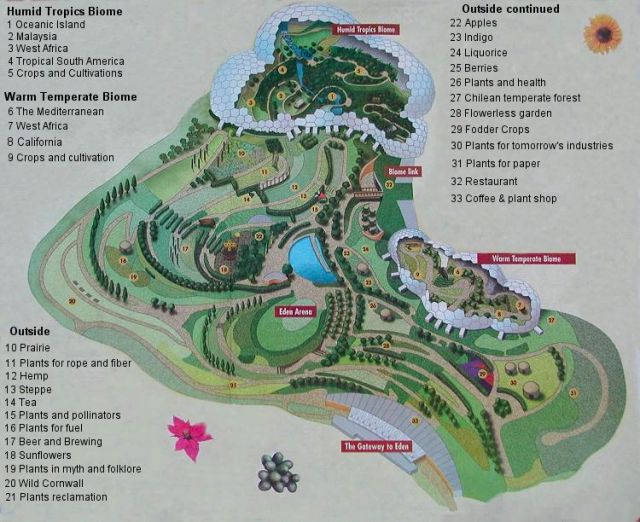
|
Eden Project Contact Details
Phone: +44 (0)1726 222900
Fax: +44 (0)1726 222901
Mail: Eden Project, Watering Lane Nursery, Pentewan, St Austell, Cornwall
PL26 6BE
|
You can click here to see a page with more, different
pictures about my visit.
|
